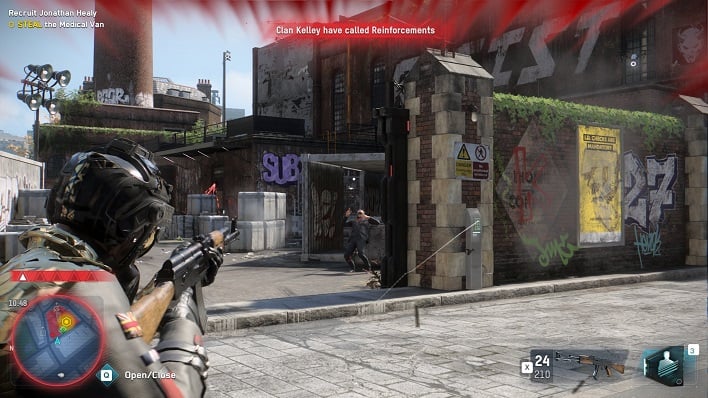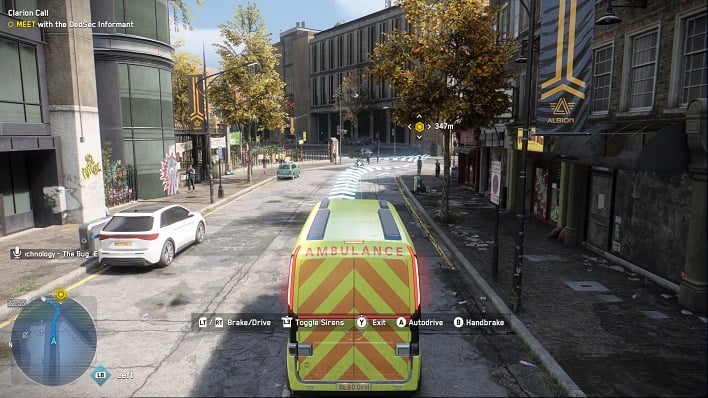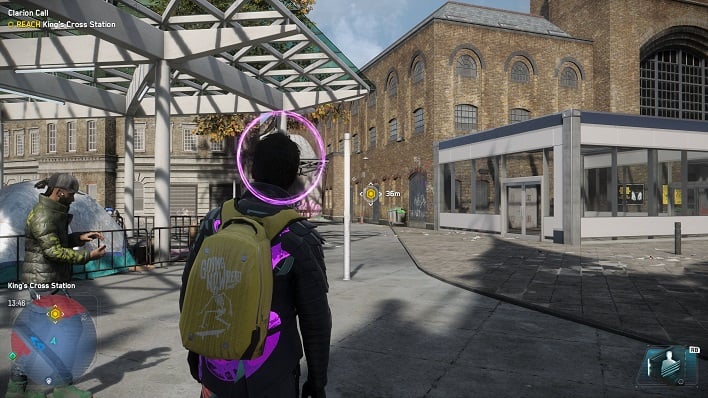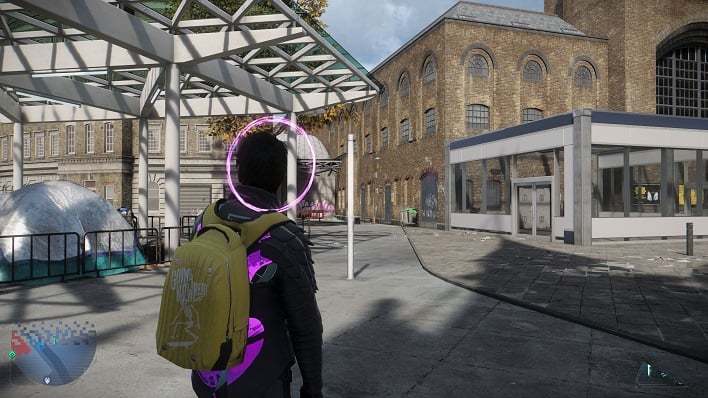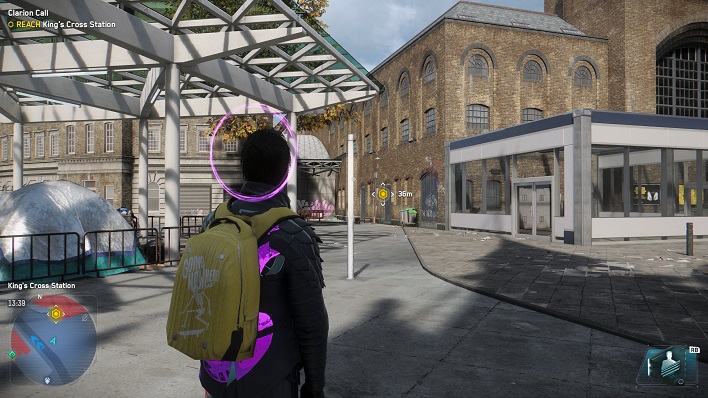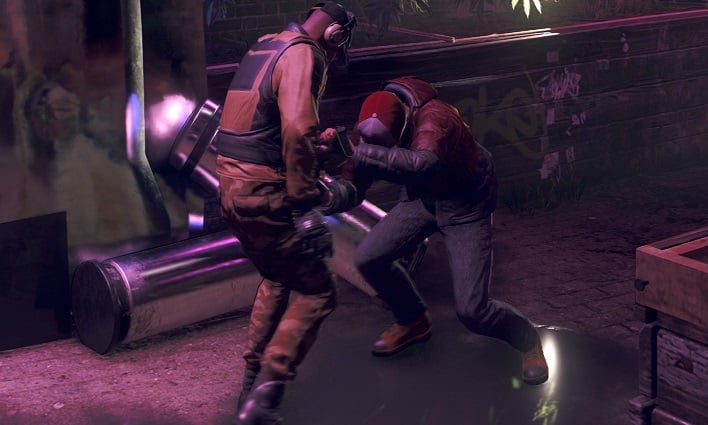Watch Dogs: Legion Graphics, Game Play & Performance Explored
Watch Dogs: Legion - London Has Fallen
The war of the Watch Dogs series has always been fought in two parts -- physically with weapons and by proxy in the online space. In the original, which took place in Chicago, hacker Aiden Pearce, aided by the DedSec crew, hacks just about any device in his vicinity on his quest to make up for the loss of his niece, Lena, and take down a mysterious software called Central Operating System (ctOS) that ran the city and spied on its citizens. Then in Watch Dogs 2, players entered the shoes of Marcus Holloway, a DedSec activist whose goal it was to overcome ctOS version 2.0 in San Francisco while simultaneously exploiting its weaknesses for their own gain. This time around in Watch Dogs: Legion, ctOS and a private military group called Albion have taken over London.
Unlike the previous games, you're not a specific individual with a particular set of skills. Early on during a prologue segment, players control Dalton Wolfe, a British MI5 agent who just so happens to be a part of (you guessed it) DedSec. Wolfe walks into a planned bombing of Parliament that he's able to stop. Unfortunately, the culprits, a second hacker group called Zero Day, set off more explosions around the city and kill Wolfe on the roof of the Parliament building.
Following Wolfe's death, Albion sweeps into London and locks the city down as part of a coup following the bombings. The privatized military group spins a misinformation campaign framing DedSec for the series of bombings, and gains control of London by using (once again, you've guessed it) another version of ctOS. Players then take control of one of a large list of possible characters to lead DedSec in the campaign against ctOS and Albion itself. This is just the first in a grocery list of changes to the core mechanics in an effort to keep the Watch Dogs franchise feeling fresh.
Watch Dogs: Legion - Plot Overview
Watch Dogs: Legion is equal parts stealth and sneaking around, like Assassin's Creed, with sandbox car thievery and evading law enforcement with one of several playable characters, similar to Grand Theft Auto V, and a healthy dose of futuristic hacking simulator. Albion has locked down all of London as a whole, but DedSec's plans include freeing it one borough at a time.You're not on your own, though. Right from the start, we were in constant communication with Sabine Brandt, the last remaining leader of DedSec. Intelligence comes from Sabine's smarmy British AI partner Bagley, who's clearly based on British comedians like Ricky Gervais. This all-knowing computer has access to limitless checkpoints and surveillance equipment, but is quicker to make jokes than give answers. At first, not getting a straight answer from an AI assistant is funny and a little charming, but it quickly turns repetitive and annoying. We prefer our AI to be helpful and compliant, like Lt. Commander Data from Star Trek.
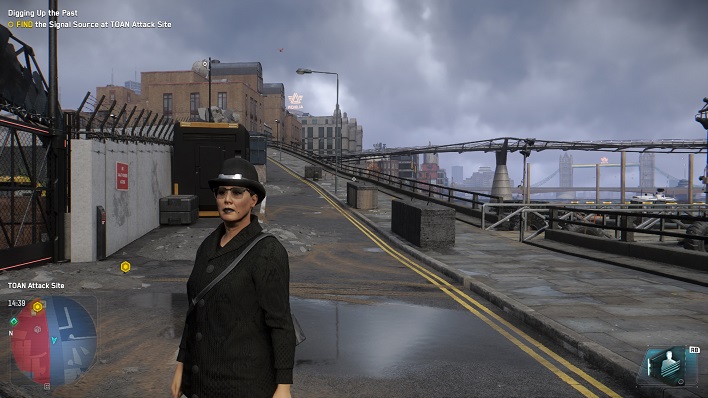
While modern-day London has 32 boroughs, Watch Dogs: Legion condenses that down to nine. The goal is to free each of them by interrupting Albion's propaganda campaign, recruiting new members into DedSec with desirable skills, and infiltrate a series of bases spread around the city. Once you've completed a series of missions in a borough, it will start resisting Albion, which opens up opportunities to recruit more members, unlocks additional side missions, and usually grants access to new skills and technologies.
Watch Dogs: Legion - Gameplay Mechanics
The in-game version of London is huge, so getting around requires going on foot, using a fast-travel tunnel system, or commandeering a car. Fortunately, DedSec recruits don't have to pull people from their vehicles to steal them, since roughly half of the cars we've encountered so far are driverless meandering vehicles ripe for the taking. They might be driverless taxis, but Albion agents don't seem to mind when we hop in one and drive it manually.Combat focuses heavily on stealth. Much like Assassin's Creed, we can take an enemy down from behind with a single button. Each character has their own signature takedown stylings that range anywhere from simple choke holds to vicious but quick tazering. All the takedown moves we used felt right for the personality of the character we were playing at the time. It's satisfying to sneak up on every enemy in a base, or set traps that cause enemies to take themselves out, and sometimes their friends along with them.

If stealth fails, get ready to fight, be it in close-quarters or with firearms. The guns, at least to the point of the campaign that we've played so far, are kind of boring and unimaginative handguns, rifles, and the like. Firearms feel pretty good in action, and do significant realistic damage. Headshots are almost guaranteed kills unless we were fighting an opponent with a helmet, and everyone recoils when they're hit anywhere on the body. Operatives need to take cover when under fire, and that system works very similar to Gears of War with its one-button cover and vaulting mechanics. Damage appears on-screen first with red outlines in the fringes, and eventually the world goes black and white. Disappointingly, healing only requires getting out of combat for a few seconds, and then apparently our fast Wolverine-style healing powers kick in.
Melee combat is surprisingly deep, with a rock/paper/scissors style setup. The three buttons are Attack, Guard Break, and Dodge. Attacks are pretty straightforward punches and kicks that chain easily into combos. When an enemy has taken a defensive pose, use Guard Break to grab them and hurt them where they're vulnerable. For example, if they've started blocking punches to the head, a Guard Break will stomp on their knee or punch them in the ribs, making them vulnerable again. And when they've gone on the offensive, use the Dodge button to get out of the way. Follow that up with a quick press of the Attack button and you can land powerful counters. Finally, finish the enemy using the stealth takedowns, only more flashy and violent since there's no reason to keep quiet.
All of the playable characters have their own set of skills, too, which range from access to construction drones to a fast cooldown on hacking timers. Recruiting characters involves approaching them on the street and just asking them to join. They always immediately recognized us as a member of DedSec, and then spilled their life story on the spot. There's always some sort of favor they need before they'll be swayed over to our side. It might be taking out a loan shark, hunting down a mob boss's dirty doctor, or finding a lost relative. Whatever the case, finishing their recruitment is just a side mission away.
We found that we need as many operatives as we can get, too. When one gets knocked out in an altercation with Albion, they'll be arrested or hospitalized. After enough time has passed, they'll eventually be released back to full health and can rejoin the recruits. Fortunately, this can be sped up with the assistance of the right type of recruit. When the time is right, such as when an operative is down for the count, Bagley will suggest recruiting someone that can help, at which point it's just a matter of completing a recruitment mission. This bonus will stick with the party until that character is either incarcerated or injured themselves. These recruitment missions can take a while and often involve driving across town more than once, but the bonus is very worthwhile.
Watch Dogs: Legion also an option for Permadeath, in which there's a chance those characters will die permanently, which adds a unique rogue-like twist. Characters don't always die when they lose a fight, but when they do, it's forever. This is a separate setting in the Gameplay menu. That means option to play on Easy with Permadeath is possible, so the risk could be low, but still always present and making for an interesting consequence. Right now, Watch Dogs: Legion is a single-player campaign only, but multi-player modes are scheduled to appear in December.
Watch Dogs: Legion - Graphical Enhancements
Since Watch Dogs: Legion is an NVIDIA showcase, it makes heavy use of the Green Team's one-two combination of DirectX Raytracing (DXR) and Deep Learning Super Sampling (DLSS) anti-aliasing version 2.0. These features both require NVIDIA's GeForce RTX graphics cards, including the previous-gen GeForce RTX 2060, 2070 and 2080 (along with their Super and Ti incarnations) or a recently-released Ampere GeForce RTX 3000 series card. DXR uses the RT cores in the GPU to cast ray traced lighting, while DLSS 2.0 puts the Tensor cores used for AI inferencing to work upscaling the lower-resolution image to fit the game's target resolution.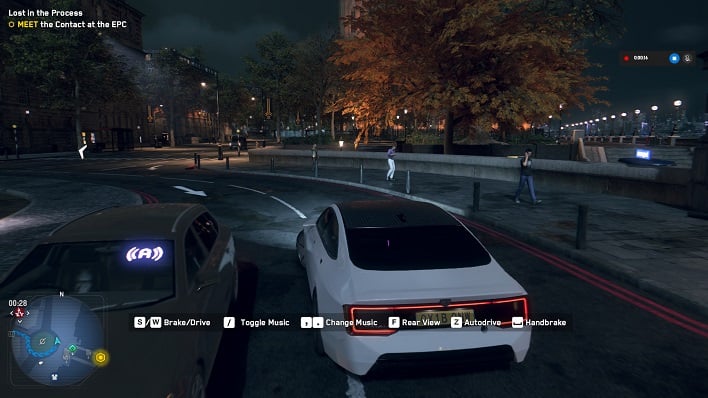
We played at a UHD 4K resolution of 3,840 x 2,160. All of the screenshots in this section are small 100% crops in the article. Clicking on one will show the full scene with that section in context. This kind of under the microscope inspection will tease out differences between the different settings, but in motion and from a distance (like the 12 feet from our 55" UHD TV) it's really not as dramatic as it might seem. If you prefer to play at a desk, up close and personal with a monitor, however, this could mean a big difference.
First, Ubisoft employed DXR in reflections on anything that can cast them. That means glass windows, polished metal surfaces, and water. There are three levels of DXR used here, and each one only affects how detailed the reflections are. Lower detail casts fewer rays, and those rays are blended together to look like the object in the reflection. These are generally pretty nice, but the fallback routine that draws reflections with traditional rasterized rendering are also pretty solid. Unlike a game like Control that looked totally different with DXR effects, Watch Dogs: Legion looks better, but the change is not nearly as drastic as it was before.
Let's take a look at each setting in detail. In the scene below, reflections are cast off of the giant windows in a building in a downtown area. We'll start with the highest quality setting, labeled Ultra in the menu, and work our way down to the lowest setting, in this case when DXR settings are turned off entirely. Again, click the small images to see the bigger version, but we think that you might be able to tell a difference when DXR is off without clicking.
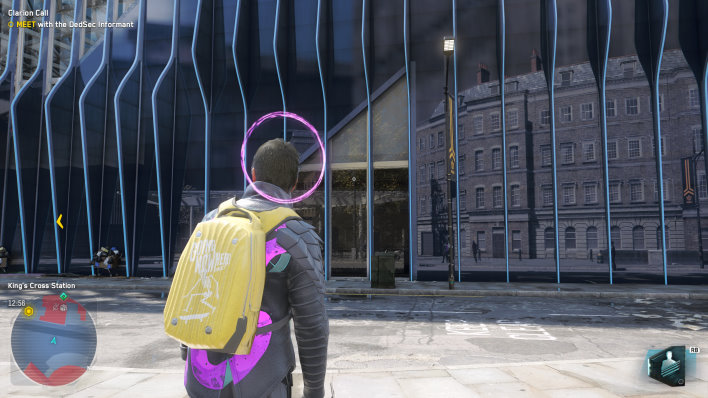
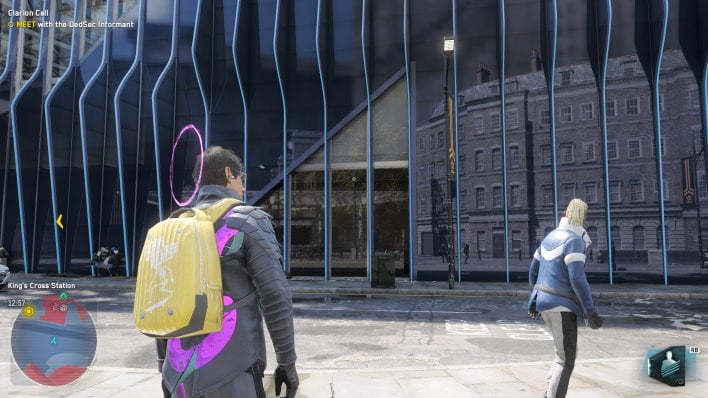
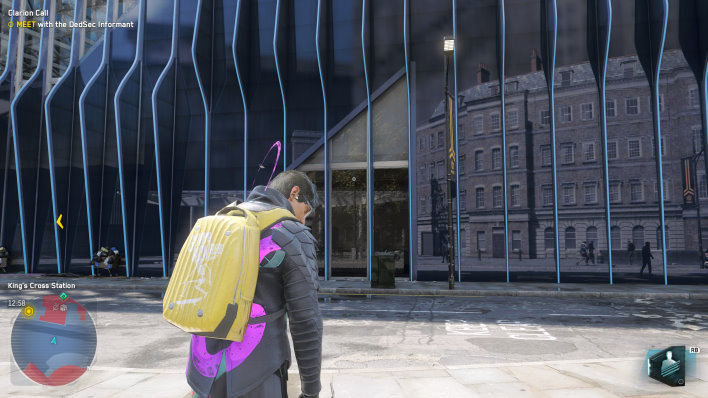
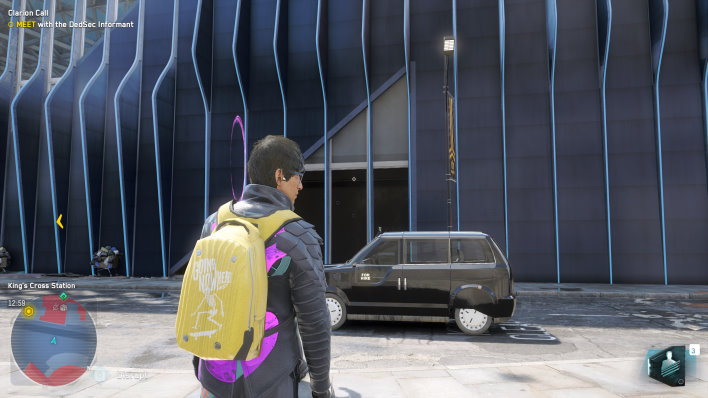
The differences between Ultra, High, and Medium are all pretty subtle here. The difference is caused by the resolution at which the reflection is rendered, which has an impact on how many rays need to be cast and traced in the reflection. Overall, each setting down from Ultra is a little less finely detailed, right up until we turn DXR off entirely. Then there are no reflections in the windows, but we can see a little reflection in a passing car. This is a traditionally rendered reflection, not ray tracing. As we'll see in the Performance section, enabling DXR at all has a pretty significant impact on frame rates, and each setting up the ladder results in fewer frames per second, as expected.
At least on the GeForce RTX 2080 SUPER 8 GB and RTX 2060 6 GB we tested, DLSS will salvage solid performance when those DXR effects are running. Watch Dogs: Legion uses DLSS 2.0 that debuted with Control and MechWarrior 5 earlier this year. The game has settings for Quality, Balanced, and Performance, and then a new mode, Ultra Performance. This new mode renders just one-ninth the number of native pixels and upscales to the target. For 8K gaming, a feature heavily pushed by NVIDIA at the Ampere launch, that means it would render the game at 1080p and then upscale to 7,680 x 4,320. That reduces the strain considerably, and helps the game push pixels at acceptable frame rates.
As in the other games, each mode sets a render resolution that matches a percentage of pixels in the target resolution, and then uses machine learning models to upscale the rendered resolution to the target. The result has been much greater performance with a minimal compromise on image quality. Let's take a look at several settings here, starting with no DLSS and working our way up to Ultra Performance. Be sure to click the images below to see big-sized versions where the differences are much more obvious.
We're going to concentrate on the scaffolding on the left side here since that's where the biggest differences are. With DLSS disabled, the shadow is rendered at its full native resolution at 4K, and the edges of the shadows are all pretty smooth. Stepping the resolution down to Quality results in a little pixelation in the shadows, but the architecture remains true to form and has very smooth edges. Balance looked very similar, so we passed over that setting and went straight for Performance. Here, the shadows start to look very pixelated, but the architecture is still unaffected. Even the foliage behind the scaffolding looks pretty nice. Lastly, Ultra Performance at 4K means that it's rendering just a 1,280 x 720 image, and the scaffolding starts to look warped at different angles. This was just a bridge too far for this setting, but on an 8K display where it renders at 2,560 x 1440, it probably looks just fine.
When we played the game on our 4K TV, we used a dedicated PC we keep in the living room, which has a Core i5-9400F and a GeForce RTX 2070 SUPER. To keep frame rates playable and the game looking nice, we used Medium DXR reflections with the Performance DLSS setting. One other piece of the performance puzzle is the game's main graphics preset, which affects things like draw distance, texture resolution, and the like. We were limited to Very High, since Ultra required more VRAM than the 8 GB GeForce had available. Folks who want to play on Ultra will need a 10 GB GeForce RTX 3080 or 11 GB GeForce RTX 2080 Ti at a minimum just to have enough VRAM. Sitting on the couch across the room from our 55" TV, we didn't really see much difference between DLSS and the native resolution, or the Ultra DXR compared to Medium.
One last thing about graphics: there is so much graphical polish in the game that problems stand out like sore thumbs. The biggest problem we saw is in the water. When there's standing water on the sidewalk or in the street, it reflects everything around it when DXR is on, and there's even splashes as raindrops hit the water. But when something in the environment interacts with a water puddle, there's zero response. No splashing, no water displacement. It's like the characters are dancing on glass or a frozen lake. This was very apparent in the in-game benchmark, and because we ran that test more than 100 times, it really stuck out. It also happens in the game itself, and it's kind of distracting. It'd be nice if there was a little hint of a splash or something, just so that it felt like the environment wasn't so static.
Next up we'll discuss performance and have a word about Watch Dogs: Legion's stability...

